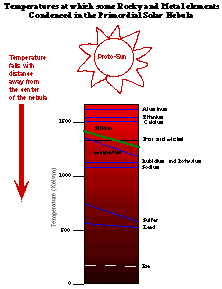This is a schematic showing where material forms.
Click on image for full size
Image from: After Moons and Planets
The effect of Temperatures on the condensation of certain materials
This diagram shows that when the nebula is very hot, the rocky materials such as Calcium, Magnesium, Iron, Nickel, and Lead, that the terrestrial planets are made of, will begin to form close to the sun, but that the ice of which Uranus is made will not condense unless the temperature is very low. Thus the Earth could never have as much ice as Uranus has.
In the picture, the proto-sun is shown at the top, and the temperature in the nebula is shown to decrease with distance away from the proto-sun, towards the bottom of the drawing. The temperature at which ice begins to form is the freezing temperature, near 250 K on the diagram. The temperature at which rocky material can begin to form is much higher.
You might also be interested in:

Minerals are the building blocks of rocks. They are non-living, solid, and, like all matter, are made of atoms of elements. There are many different types of minerals and each type is made of particular
...more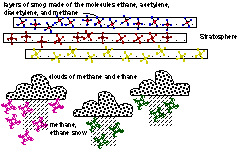
Besides methane, Uranus' atmosphere contains even more complex molecules such as ethane gas. (These gases are similar to the exhaust gases that come out of cars on earth). These molecules form layers of
...more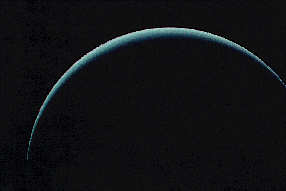
The mesosphere of Uranus is a region of balance between warming and cooling. That essentially means that nothing happens there. Except for diffusion, the atmosphere is still. Upper reaches of the atmosphere,
...more
As on Earth, the atmosphere of Uranus consists of a troposphere, stratosphere, mesosphere, and thermosphere. The troposphere is the region where the visible clouds are to be found. The stratosphere, as
...more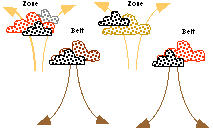
On Uranus, as on Jupiter, the winds in the belts and zones blow first in one direction, then in the opposite direction. Wind blows east in a belt, and west in a zone. The clouds rise up in a belt, and
...more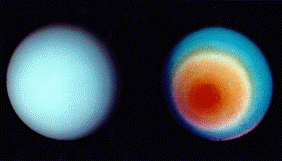
The clouds on Uranus, like Jupiter, are divided into belts and zones. On Uranus the belts and zones are hard to find. The left picture shows the north pole of Uranus. In this picture only the smog of
...more
The clouds of Uranus, composed of methane crystals, are found very low in the atmosphere, and are difficult to see below the smog haze s of the planet. False color is used, in the image of Uranus to the
...more


